Read the given passage and answer the following questions :
Food chains and the energy flow within an ecosystem provide an important understanding of contingencies and mutual dependencies of organisms. The flow chart given below, depicts the energy flow within some members of a grassland ecosystem. The grass in the below ecosystem transduces 120,000 J of sunlight and fixes it into 12,000 J of energy. It is established that 90% of the energy of one trophic level is not passed to the next trophic level. Further assume that the energy transferred from one trophic level to the next is equally shared among the different organisms at that trophic level. Based on the information given and your knowledge, answer the following questions.
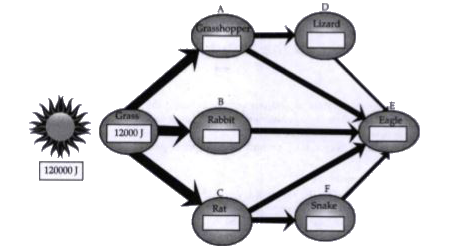
The first trophic level in a food chain is always a green plant. Why?
Step by step video & image solution for Read the given passage and answer the following questions : Food chains and the energy flow within an ecosystem provide an important understanding of contingencies and mutual dependencies of organisms. The flow chart given below, depicts the energy flow within some members of a grassland ecosystem. The grass in the below ecosystem transduces 120,000 J of sunlight and fixes it into 12,000 J of energy. It is established that 90% of the energy of one trophic level is not passed to the next trophic level. Further assume that the energy transferred from one trophic level to the next is equally shared among the different organisms at that trophic level. Based on the information given and your knowledge, answer the following questions. The first trophic level in a food chain is always a green plant. Why? by Biology experts to help you in doubts & scoring excellent marks in Class 10 exams.
Updated on:21/07/2023Topper's Solved these Questions
- OUR ENVIRONMENTBOOK - OSWAL PUBLICATIONCHAPTER - OUR ENVIRONMENTEXERCISE - SELF ASSESSMENT - 1 (OBJECTIVE TYPE QUESTIONS (ASSERTION AND REASON TYPE QUESTIONS)
2 Videos
- OUR ENVIRONMENTBOOK - OSWAL PUBLICATIONCHAPTER - OUR ENVIRONMENTEXERCISE - SELF ASSESSMENT - 1 (OBJECTIVE TYPE QUESTIONS (VERY SHORT ANSWER TYPE QUESTIONS)
3 Videos
- OUR ENVIRONMENTBOOK - OSWAL PUBLICATIONCHAPTER - OUR ENVIRONMENTEXERCISE - SELF ASSESSMENT - 1 (OBJECTIVE TYPE QUESTIONS (MULITIPLE CHOICE QUESTIONS))
3 Videos
- OLYMPIAD 2019 - 20BOOK - OSWAL PUBLICATIONCHAPTER - OLYMPIAD 2019 - 20EXERCISE - BIOLOGY QUESTIONS (Why Do We Fall III)
1 Videos
- REPRODUCTIONBOOK - OSWAL PUBLICATIONCHAPTER - REPRODUCTIONEXERCISE - BOARD CORNER (Long Answer Type Question)
9 Videos
Similar Questions
Food chains and the energy flow within an ecosystem provide an important understanding of contingencies and mutual dependencies of organisms. The given below flow chart depicts the energy flow within some members of a grassland ecosystem. The grass in the below ecosystem transducer 120,000 J of sunlight and fixes it into 12,000 J of energy. It is established that 90% of the energy of one trophic level is not passed to the next trophic level. Further assume that the energy transferred from one trophic level to the next is equally shared among the different organisms at that trophic level.
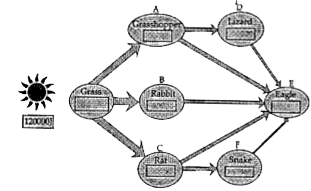
How many food chains are present in the food web depicted above?
View SolutionFood chains and the energy flow within an ecosystem provide an important understanding of contingencies and mutual dependencies of organisms. The given below flow chart depicts the energy flow within some members of a grassland ecosystem. The grass in the below ecosystem transducer 120,000 J of sunlight and fixes it into 12,000 J of energy. It is established that 90% of the energy of one trophic level is not passed to the next trophic level. Further assume that the energy transferred from one trophic level to the next is equally shared among the different organisms at that trophic level.
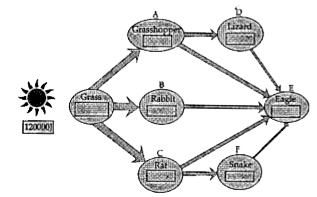
Tropic levels are formed by which of the following components?
View Solution
Knowledge Check
Energy flow in an ecosystem is
AunidirectionalBbidirectionalCmultidirectionalDNone of thesePath of energy flow in an ecosystem is
AHerbivores → Producers → Carnivores → DecomposerBHerbivores → Carnivores → Producers → DecomposerCProducer → Carnivores → Herbivores → DecomposerDProducer → Herbivores → Carnivores → DecomposerPath of energy flow in an ecosystem is:
AHerbivore →Producer → Carnivore →DecomposerBHerbivore → Carnivore → Producer → DecomposerCProducer → Carnivore → Herbivere →DecomposerDProducer → Herbivore → Carnkore → Decomposer
Food chains and the energy flow within an ecosystem provide an important understanding of contingencies and mutual dependencies of organisms. The given below flow chart depicts the energy flow within some members of a grassland ecosystem. The grass in the below ecosystem transducer 120,000 J of sunlight and fixes it into 12,000 J of energy. It is established that 90% of the energy of one trophic level is not passed to the next trophic level. Further assume that the energy transferred from one trophic level to the next is equally shared among the different organisms at that trophic level.
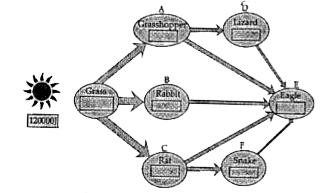
Which organism acts as both the secondary consumer and the tertiary consumer?
View SolutionFood chains and the energy flow within an ecosystem provide an important understanding of contingencies and mutual dependencies of organisms. The given below flow chart depicts the energy flow within some members of a grassland ecosystem. The grass in the below ecosystem transducer 120,000 J of sunlight and fixes it into 12,000 J of energy. It is established that 90% of the energy of one trophic level is not passed to the next trophic level. Further assume that the energy transferred from one trophic level to the next is equally shared among the different organisms at that trophic level.
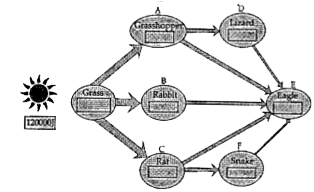
In the food web depicted above, identify the most energy efficient link for tertiary consumer.
View SolutionFood chains and the energy flow within an ecosystem provide an important understanding of contingencies and mutual dependencies of organisms. The given below flow chart depicts the energy flow within some members of a grassland ecosystem. The grass in the below ecosystem transducer 120,000 J of sunlight and fixes it into 12,000 J of energy. It is established that 90% of the energy of one trophic level is not passed to the next trophic level. Further assume that the energy transferred from one trophic level to the next is equally shared among the different organisms at that trophic level.
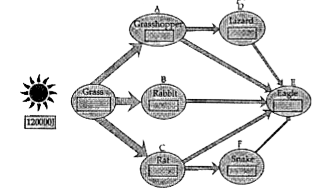
Based on the above information, indicate the amount of energy that an organism C may have received from an organism from the previous trophic level.
View SolutionDescribe energy flow in an ecosystem
View SolutionComplete the flow chart given below:

View Solution
